Create wildlife-friendly vertical boundaries in your garden with native hedgerows, climbing plant trellises, berry screens, log walls, mixed species plantings, drought-resistant gardens, espaliered fruit trees, green sound barriers, and layered plantings. These natural boundaries provide food, shelter and nesting sites while enhancing your privacy and supporting local ecosystems. Each option offers unique benefits for different wildlife species, transforming your garden edges into thriving habitats for birds, insects, and small mammals.
Native Hedgerows: Living Boundaries for Local Wildlife
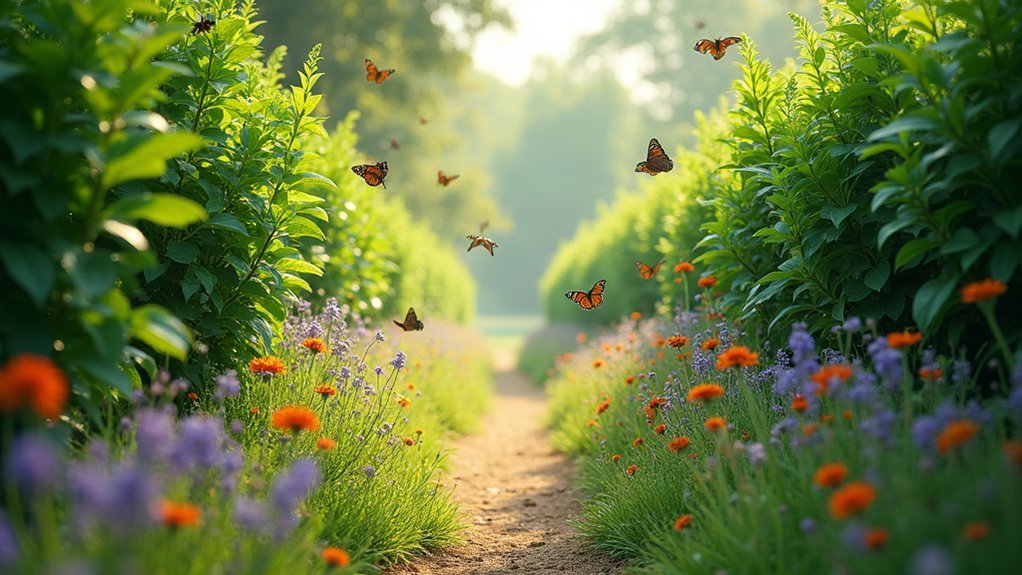
While many gardeners focus solely on cultivating flowers and vegetables, native hedgerows offer a powerful way to transform your garden’s boundaries into thriving wildlife sanctuaries.
These living fences, composed of indigenous species like hawthorn and blackthorn, create essential habitats for birds, insects, and small mammals throughout the year.
You’ll find that native plants require less maintenance than exotic alternatives while providing food and shelter for local wildlife.
The dense structure of hedgerows serves as corridors allowing creatures like hedgehogs to travel safely between gardens during foraging trips.
Beyond supporting biodiversity, these natural boundaries reduce noise pollution and enhance privacy in your outdoor space.
Climbing Plant Trellises That Support Pollinators
When you’re looking to maximize your garden’s vertical space for wildlife, climbing plant trellises offer an ideal solution that benefits both your aesthetic preferences and local pollinators.
Choose a variety of flowering climbing plants with staggered bloom times, such as sweet peas, clematis, and honeysuckle, to provide continuous nectar sources throughout the growing season.
Thoughtful plant succession ensures your trellis garden remains a vibrant nectar bar from spring through fall.
Position your trellises in sunny locations to encourage abundant flowering and attract more pollinators.
Native climbing plants like Virginia creeper and climbing hydrangea are particularly effective at drawing local species that have evolved alongside these plants.
You’ll also be creating valuable shelter where pollinators can escape predators and harsh weather.
Berry-Producing Fence Screens for Bird Habitats
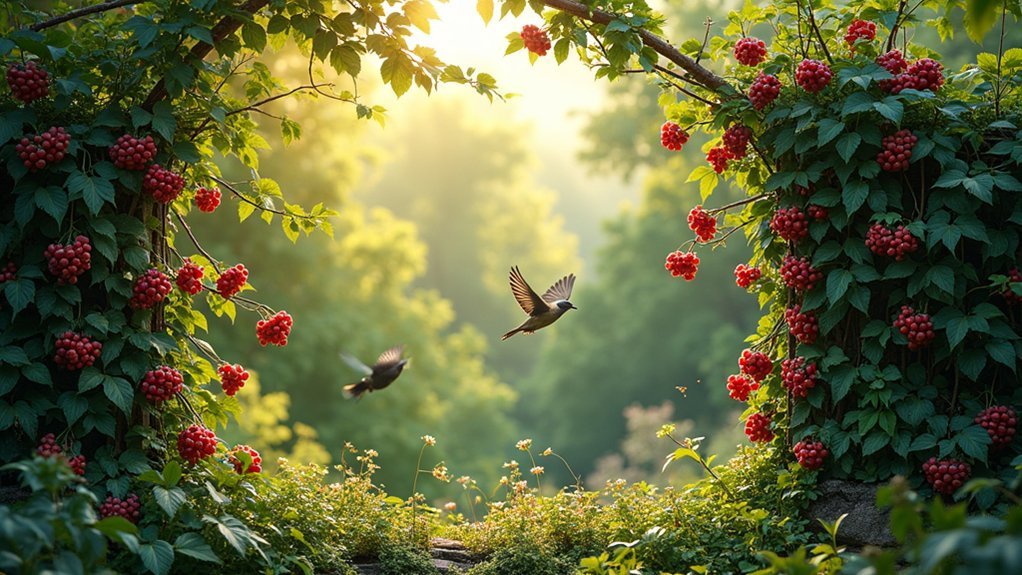
Berry-producing fence screens offer you an elegant way to transform your property boundaries into essential bird habitats while enjoying natural privacy.
You’ll find that incorporating bird-attracting options like elderberry and serviceberry provides both sustenance and shelter throughout multiple seasons, as different species fruit at varying times from spring through fall.
Berry-Rich Climbing Vines
Three magnificent climbing vines can transform your ordinary fence into a vibrant wildlife haven. The American Beautyberry, Black Raspberry, and Virginia Creeper all produce berries that attract cardinals, finches, and thrushes to your garden boundaries.
You’ll create valuable vertical habitats when you train these berry-producing climbing vines along fences and trellises. They don’t just provide food—they offer dense cover for nesting birds and essential shelter during harsh weather.
As native species, these vines require minimal maintenance while supporting your local ecosystem more effectively than non-native alternatives.
They’ll establish multi-layered boundaries that serve as wildlife corridors, allowing animals to travel safely between different garden areas.
Bird-Attracting Hedge Options
Establishing a vibrant hedgerow filled with berry-producing shrubs creates an ecological powerhouse along your property line. Choose native plant species like hawthorn, blackthorn, and guelder rose, which offer dense protective foliage for nesting while providing essential nutrition through their abundant berries.
You’ll attract diverse bird species when you mix deciduous options such as blackcurrant and raspberry, which offer spring flowers for pollinators before transforming into bird-friendly fruit sources. Thrushes and blackbirds particularly benefit during migration seasons when energy demands peak.
Don’t forget to prune outside nesting season to encourage robust growth and maximize berry production. Thorny varieties like blackthorn serve double duty by creating protective sanctuaries while offering winter sustenance through their sloe berries.
This thoughtful combination of security and food supply makes your hedge an invaluable wildlife corridor.
Multi-Season Fruiting Barriers
When you transform your ordinary fence line into a multi-season fruiting barrier, you create a living pantry that serves birds throughout the year. Blackberries, raspberries, and elderberries don’t just offer delicious harvests for your kitchen—they provide critical food sources and shelter for diverse wildlife.
Plant native berry-producing plants like serviceberry and blueberry to support species that have co-evolved with local ecosystems. Their staggered fruiting schedules guarantee continuous nourishment for birds across seasons, preventing the feast-or-famine cycles common in singular plantings.
Utilize vertical spaces by training berry canes along fences and trellises, creating effective wildlife corridors that connect fragmented habitats. These natural screens offer protection and nesting sites while serving as navigational routes for birds moving through your landscape.
Vertical Log Walls as Insect Sanctuaries
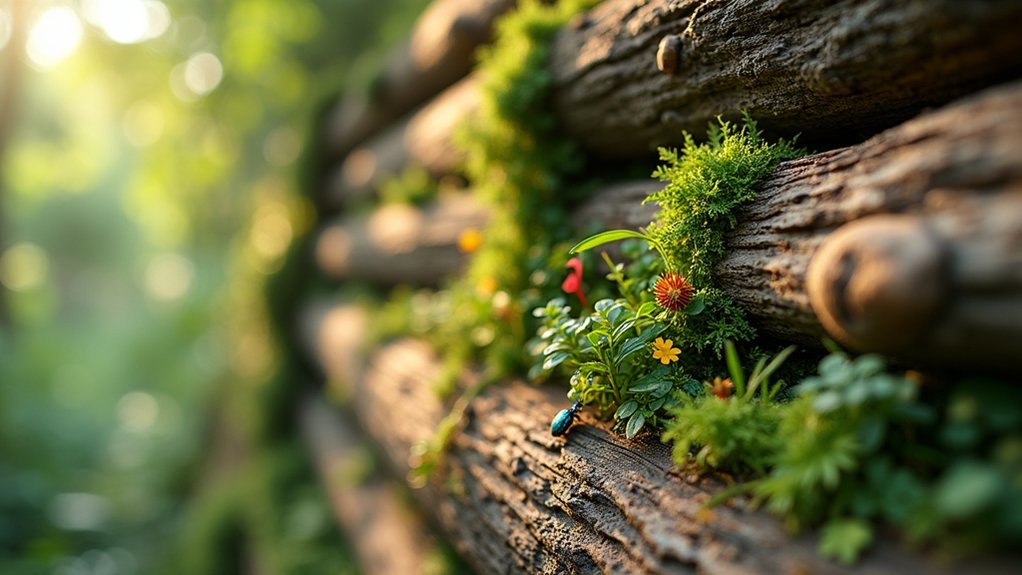
While many gardeners focus on horizontal spaces for wildlife, vertical log walls serve as essential sanctuaries for countless insects seeking shelter and sustenance. The textured crevices between logs provide shelter for beetles, spiders, and solitary bees, creating microhabitats that traditional garden features can’t match.
You’ll notice mosses and lichens naturally colonizing these structures, offering additional food sources for insects to eat. The vertical orientation maximizes garden space while creating diverse ecological niches that flat surfaces simply can’t provide.
For best results, surround your log wall with native plants to attract pollinators and beneficial insects. The wall’s ability to maintain consistent humidity levels creates ideal conditions for moisture-loving species, enhancing your garden’s biodiversity and ecological balance throughout the seasons.
Mixed Species Boundaries for Year-Round Wildlife Support
You’ll transform your garden boundaries into thriving ecosystems by combining native and non-native plants that support seasonal food chains from spring blossoms to winter berries.
Staggering flowering schedules guarantees continuous nectar sources, creating an unbroken support system for pollinators and the birds that feed on them.
The natural layering of mixed species boundaries—from ground cover to tall shrubs—provides diverse habitats where wildlife can find food, shelter, and nesting sites throughout the year.
Seasonal Food Chain Support
The secret to a thriving wildlife garden lies in creating mixed species boundaries that support food chains throughout the year.
Even in a small garden, your plant choices can create a continuous buffet for local fauna, ensuring your vertical boundaries serve as wildlife corridors across seasons.
- Incorporate early bloomers like snowdrops and crocuses to provide essential nectar for emerging pollinators in spring
- Mix in summer-flowering herbs and shrubs to attract beneficial insects that form the base of the food chain
- Add fruit-bearing plants such as raspberries which feed birds while creating vertical structure
- Include evergreen species with winter berries to sustain birds when food is scarce
You’ll soon notice how your carefully planned boundaries transform into dynamic ecosystems, with each plant playing an important role in supporting wildlife year-round.
Staggered Flowering Schedules
Creating a garden with staggered flowering periods transforms ordinary boundaries into year-round wildlife sanctuaries.
By combining species that bloom in different seasons, you’ll provide continuous nectar and pollen sources that sustain diverse pollinator communities throughout the year.
Start with early spring bloomers like snowdrops and crocuses that nourish emerging insects after winter.
Shift to summer flowering plants such as echinacea and zinnias that fuel pollinators during peak activity months.
Don’t forget fall performers like asters and sedum that support wildlife preparing for winter.
This thoughtful mix of native and non-native flowering plants creates essential wildlife corridors, ensuring bees, butterflies, and other beneficial creatures can always find food as they move through your landscape.
You’ll enjoy a constantly changing display while providing critical resources every month of the year.
Habitat Layering Benefits
When gardeners embrace the concept of habitat layering in boundary plantings, they transform simple garden edges into complex wildlife ecosystems.
You’ll create year-round support for diverse creatures by combining plants that offer different heights, densities, and seasonal attributes.
- Choose evergreens for winter shelter alongside deciduous shrubs that provide summer nesting sites
- Include native plants that attract up to 3-5 times more local wildlife than non-natives
- Maintain dense lower layers for ground-dwelling species while taller plants shelter birds
- Prune selectively rather than shearing to preserve natural habitat features
This multi-dimensional approach guarantees wildlife can find food, shelter, and breeding sites throughout changing seasons.
Your boundaries become not just garden dividers but functioning ecosystems where diverse species thrive, creating a dynamic living fence that benefits your local biodiversity.
Living Willow Structures That Shelter Small Mammals
Natural and ingenious, living willow structures offer perfect sanctuaries for small mammals seeking protection in your garden. These flexible branches, when woven into arches, domes, or tunnels, create ideal garden boundaries that double as habitats for rabbits, hedgehogs, and other small animals.
Woven willow wonders provide protective havens where garden wildlife can thrive undisturbed.
You’ll see results quickly, as willows establish roots and leafy cover within a single growing season. The dense, protective environment mimics natural hideaways, greatly reducing predation risks for vulnerable creatures.
For maximum wildlife benefit, plant diverse willow varieties to create microhabitats supporting different animal needs. Regular trimming maintains these living structures while ensuring they continue to function as year-round refuges.
These shelters seamlessly blend aesthetics with ecological function, transforming your garden edges into thriving wildlife communities that support biodiversity right outside your door.
Drought-Resistant Vertical Gardens for Urban Settings
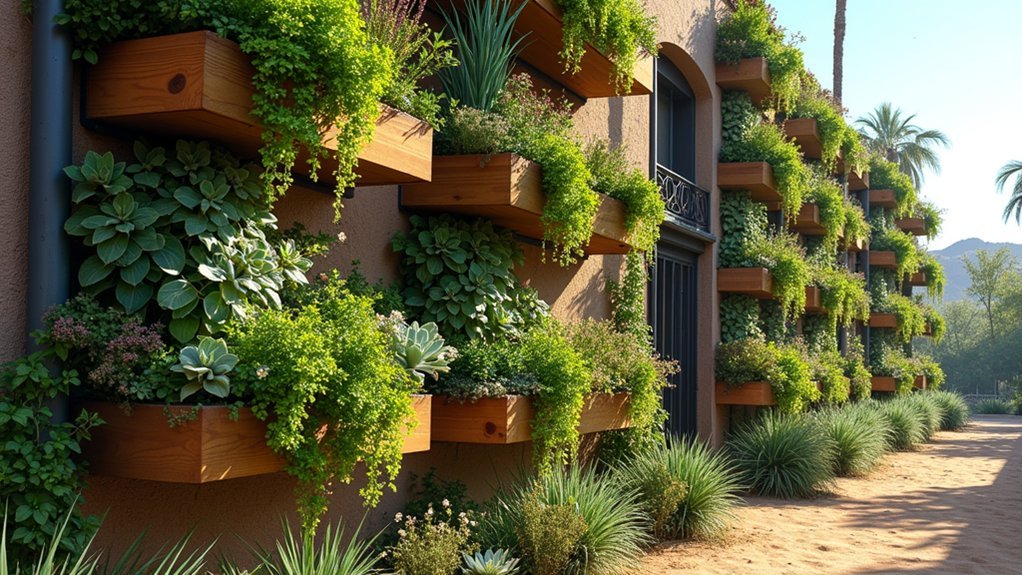
Why settle for barren concrete when your urban space can become a vertical oasis? Drought-resistant vertical gardens transform city environments into wildlife havens while conserving precious water resources.
By incorporating native plants as living walls, you’re creating habitats that support local pollinators and beneficial insects.
- Install wall planters with drought-tolerant species like lavender and rosemary to attract butterflies while requiring minimal maintenance.
- Combine succulents and cacti for striking visual appeal that thrives in hot, dry conditions.
- Implement space-efficient trellises that serve as both ground cover alternatives and vertical growing surfaces.
- Set up a drip irrigation system to deliver precise water amounts directly to plant roots.
Your vertical garden won’t just beautify urban spaces—it’ll create essential biodiversity pockets where wildlife can thrive despite limited resources.
Espaliered Fruit Trees as Productive Wildlife Corridors
Transforming your garden boundaries into living, productive ecosystems is possible with espaliered fruit trees. This space-saving technique trains trees to grow flat against walls or fences, maximizing sunlight exposure while creating essential wildlife habitats.
You’ll notice increased biodiversity as your espaliered fruit trees provide shelter and nesting sites for birds while producing accessible fruits that attract various species. The structured branches offer perfect perching spots and protection from predators.
For maximum ecological benefit, choose native fruit varieties that support local pollinators already adapted to these plants.
The beautiful, architectural forms of espaliered fruit trees won’t just enhance your garden’s appearance—they’ll create functional wildlife corridors connecting fragmented habitats in urban settings.
Your garden boundaries can serve dual purposes: defining your space while supporting the ecosystem right outside your door.
Green Sound Barriers That Double as Nesting Sites
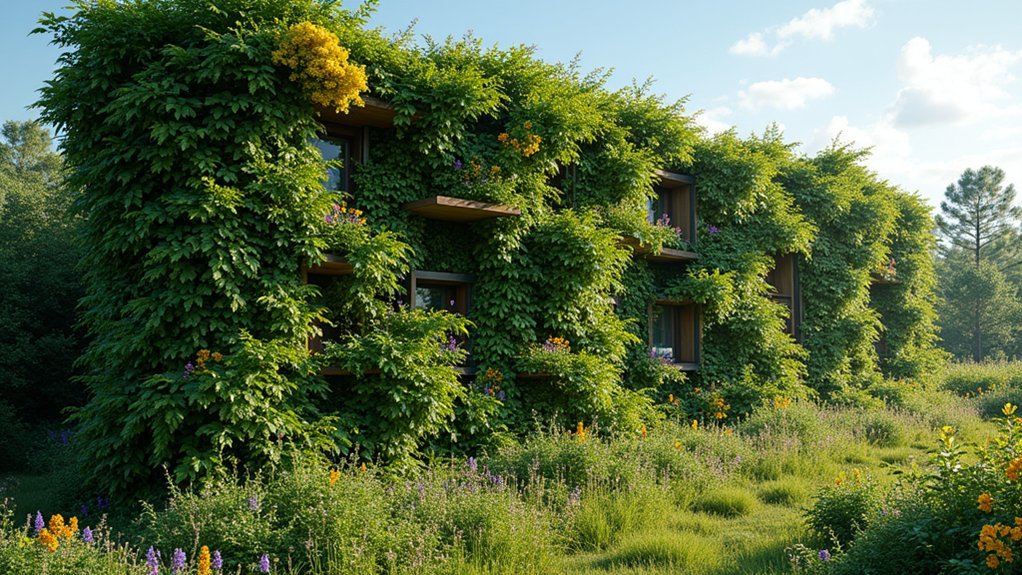
You’ll find green sound barriers offer an elegant two-fold solution for urban and suburban gardens: they buffer noise pollution while creating prime nesting real estate for birds.
Consider planting dense evergreen hedges of laurel or yew, or training climbers like ivy on trellises along property boundaries where noise intrusion is greatest.
These living barriers not only shield your outdoor space from unwanted sound but also transform ordinary boundaries into thriving wildlife corridors that support nesting birds, pollinators, and other beneficial creatures.
Wildlife-Friendly Noise Reduction
While many homeowners focus solely on reducing noise pollution around their property, green sound barriers offer a dual benefit by simultaneously creating valuable wildlife habitat.
You’ll attract diverse species by layering plants of various heights, from ground level shrubs to tall evergreens.
- Dense evergreen hedges like laurel and yew reduce noise year-round while providing nesting sites and shelter for small mammals.
- Climbing plants such as clematis and honeysuckle create vertical sound barriers that attract essential pollinators.
- Thorny species like berberis deter unwanted human access while offering wildlife protection zones.
- Native deciduous plants like hawthorn provide food sources through berries while contributing to noise reduction.
Nesting Niches Naturally
Beyond noise reduction, green sound barriers offer a perfect opportunity to create specialized nesting habitats for local wildlife.
You’ll find that dense evergreen hedges not only buffer sound effectively but provide essential shelter for birds and small mammals seeking protection.
Consider incorporating native plant species in your vertical boundaries – they’re naturally better at supporting local insects that nesting birds depend on for food.
Climbing plants on trellises create additional nesting niches where pollinators and beneficial insects can thrive.
For maximum wildlife appeal, develop varied textures and layers in your garden boundary.
Mix shrubs, vines, and flowering plants to create diverse microhabitats that support different species.
This layered approach increases nesting success by offering multiple options for wildlife to build homes according to their specific needs.
Layered Boundary Planting for Biodiversity Maximization
Creating a layered boundary around your garden serves as one of the most effective strategies for maximizing biodiversity in limited spaces.
By combining tall trees, medium shrubs, and low ground covers, you’ll establish diverse habitats for wildlife while enhancing your garden’s visual appeal.
- Use native plants to provide essential food and shelter for local fauna while reducing maintenance needs.
- Incorporate evergreens at the top layer for year-round noise and wind protection.
- Maximize vertical space with climbing plants on fences or walls to create additional insect habitats.
- Schedule pruning during non-nesting seasons to protect wildlife while maintaining plant health.
This layered approach transforms ordinary boundaries into thriving ecosystems that support numerous species throughout the seasons, turning your garden edges into biodiversity hotspots.
Frequently Asked Questions
How Much Maintenance Do Wildlife Vertical Gardens Require?
You’ll need to water your wildlife vertical garden regularly and prune occasionally. Once established, they’re relatively low-maintenance as native plants thrive with minimal intervention. Annual inspections will help identify any necessary care requirements.
Can These Boundaries Attract Unwanted Pests to My Home?
Wildlife-friendly boundaries may attract some insects, but they’ll also bring beneficial predators that control pests. You can minimize unwanted visitors by carefully selecting plants and maintaining proper spacing between the garden and your home.
How Quickly Will Wildlife Begin Using Newly Installed Boundaries?
You’ll see some wildlife within weeks of installation. Birds and insects may appear first, while small mammals might take a few months to establish regular visits once they discover your new habitat.
What’s the Minimum Space Needed for Effective Wildlife Boundaries?
You’ll need at least 3-5 feet of width for effective wildlife boundaries. Even narrow strips can support biodiversity if you’ve planted diverse native species and provided multiple vegetation layers from ground cover to canopy.
Do Vertical Wildlife Gardens Work Well in Cold Climates?
Yes, vertical wildlife gardens can thrive in cold climates if you choose hardy native plants. You’ll need to select cold-resistant species and guarantee proper insulation. They’re actually excellent for winter bird shelter and food sources.
In Summary
You’ve discovered there’s no need to choose between privacy and supporting wildlife. With these ten vertical garden boundaries, you’ll create stunning living barriers while providing food, shelter and nesting sites for local creatures. Whether you’re working with a small urban space or larger rural property, implementing even one of these natural boundary options will transform your garden into a thriving ecosystem that benefits both you and wildlife.

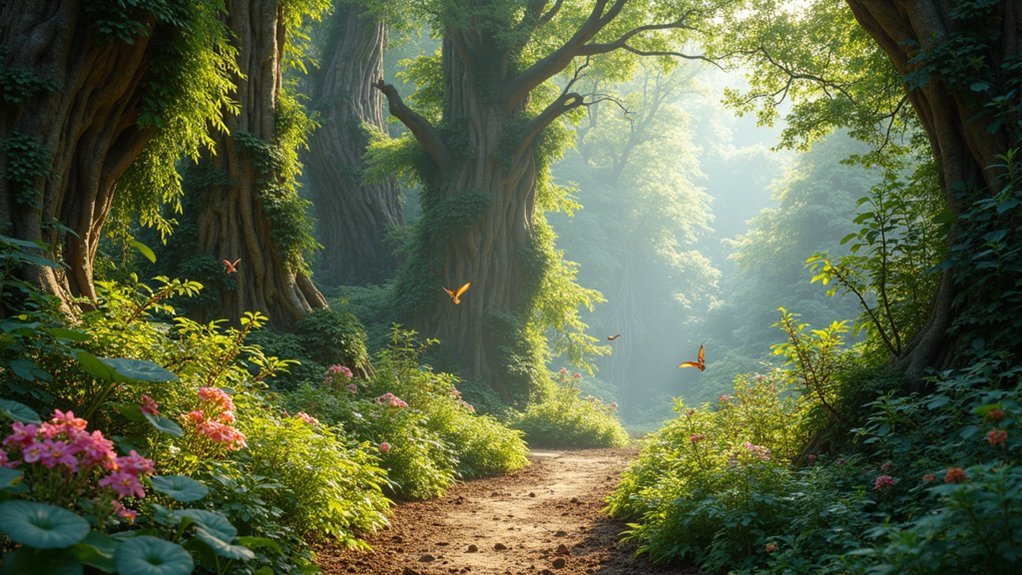



Leave a Reply